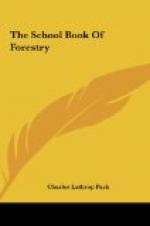When trees are grown in nurseries, the practice is to sow the seed in special beds filled with rich soil. Lath screens are used as shade. They protect the young seedlings from the sun just as the parent trees would do in the forest. The seedbeds are kept well cultivated and free of weeds so that the seedlings may have the best opportunities for rapid growth. Generally the seeds are sown in the spring between March and May. Such seeds as the elms and soft maples, which ripen in the early summer, are sown as soon as possible after they are gathered. Practical tests have shown that thick sowings of tree seeds give the best results. There is little danger of weeds smothering out the seedlings under such conditions. After the seed has germinated the beds may be thinned so that the seedlings will have more room to develop.
During the fall of the same year, or in the following spring, the seedlings should be transplanted to nursery rows. Thereafter it is customary to transplant the young trees at least once again during damp weather. When the trees finally are robust and vigorous and have reached the age of two to five years, they are dug up carefully and set out permanently. The usual practice is to keep the seedlings one year in the seedbed and two years in the nursery rows before they are set out. Whether the transplanting should take place during the spring or fall depends largely on the climate and geography of the locality. Practical experience is the best guide in such matters.
Some farmers and land owners are now interested in setting out hardwood forests for commercial purposes. If they do not wish to purchase their seedlings from a reliable nursery-man, they can grow them from carefully selected seed planted in well-prepared seedbeds. The popular practice is to sow the seed in drills about 2 to 3 feet apart so that horses may be used for cultivation. The seeds are sown to a depth of 2 to 3 times their thickness. They are placed close enough in the drill so that from 12 to 15 seedlings to the linear foot result. In order to hasten the sprouting of the seeds, some planters soak them in cold water for several days before sowing. In the case of such hard-coated seed as the black locust or honey locust, it is best to soak them in hot water before planting.
CHAPTER II
THE FOREST FAMILIES
Trees are as queer in picking out places to live and in their habits of growth as are the peoples of the various races which inhabit the world. Some trees do best in the icy northland. They become weak and die when brought to warm climates. Others that are accustomed to tropical weather fail to make further growth when exposed to extreme cold. The appearance of Jack Frost means death to most of the trees that come from near the equator. Even on the opposite slopes of the same mountain the types of trees are often very different. Trees that




